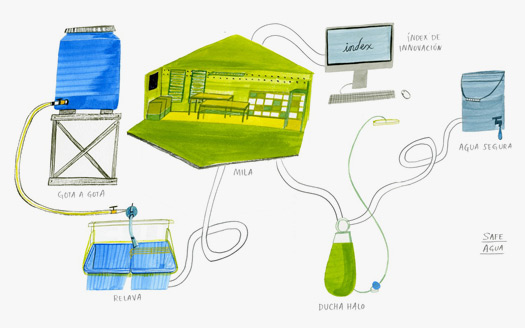
Diagram of the six interrelated Safe Agua projects. Artist: Ping Zhu
Submitted by: Mariana Amatullo
School: Art Center College of Design
Level: Undergraduate (BS) Upper-term Trans-disciplinary Studio: Disciplines participating included Environmental Design, Product Design, Graphic Design, Transportation Design and Graduate Broadcast Cinema.
Program: Designmatters, Art Center’s Social Impact Design Department
Instructors: Penny Herscovitch, Dan Gottlieb (Environmental Design) and Liliana Becerra (Product Design); Chairs: David Mocarski (Environmental Design) and Karen Hofmann (Product Design)
Class Project: Safe Agua
Date: Fall 2009
Description: The result of a Designmatters partnership initiated in 2008 with the nonprofit group Un Techo Para Chile and its umbrella organization, Un Techo Para mi País (more info here), Safe Agua addresses the quotidian challenges of safe water access for the families of Campamento San José, one of the transitional slum developments on the outskirts of Santiago, Chile. This case study presents powerful replicable dimensions both in terms of the research methodologies used for design for social innovation curricula and as it relates to the specific outcomes produced.
Felipe Berrios, a Jesuit priest who also happens to be a social entrepreneur, founded Un Techo, which translates as “A Roof for my Country,” in 1997. Berrios set about to improve conditions of poverty in Chile’s slum communities with a sustainable and inclusive model for housing and development that has produced outstanding results in addressing systemic poverty by flattening social barriers and discarding an “us versus them” view of the world. Embracing the motto, “Youth building a Latin America without poverty,” the best and brightest university students were mobilized to volunteer and meet the needs of slum residents by building transitional housing as the first stage of a comprehensive program integrating a series of long-term skill development services focusing on empowering individuals, families, and communities to take charge of their own future. Today, Un Techo serves 15 countries throughout Latin America, recruiting young professionals and university volunteers to assist over 200 million people living in extreme poverty. Un Techo’s model is fundamentally not about parachuting handouts of aid, but connecting often divided sectors of society, and ultimately building the commitment necessary for a more humane and prosperous outlook for all. As a trandisciplinary studio Safe Agua represents a unique case study and combination of design education, design research and social entrepreneurship aimed at breaking the cycle of poverty by developing new products and systems, in this case around the challenge of water access and use. The user-centered research process and methodologies developed for the project were documented in a series of blog entries published by ASHOKATech (see here). The outcomes of this studio include solutions at a range of scales — from product to system, to community spaces to campaign — to address specific water-related needs identified through that research. Six interrelated prototypes are currently in various stages of testing and real world implementation. Projects such as Safe Agua are changing design education by integrating dynamic social entrepreneurship and community activism to realize a more sustainable future.
The studio was also the inspiration of subsequent studios at Art Center that produced the Safe Agua book (Designmatters publication, upcoming release with DAP, Spring 2011); the documentary film Safe Agua Chile and the motion piece Safe Agua: The Harry Gota Story. To view the films and a gallery of images and related press articles about the project see here.
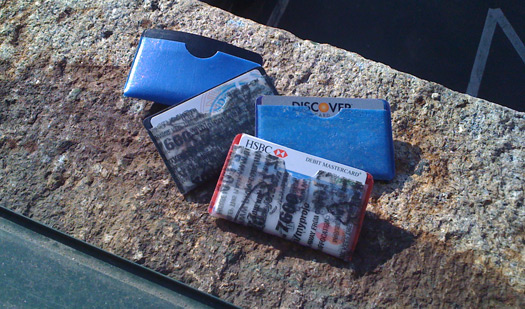
Waste for Life + RISD
Submitted by:Charlie Cannon, Project Lead
School:RISD
Level: BFA/MFA
Class Project: Waste for Life + RISD
Date: Ongoing
Description: Waste for Life + RISD is an ongoing research project at the Rhode Island School of Design to develop salable products from waste collected by gray market recyclers in Argentina. The project partners RISD with an informal network of material scientists, engineers and designers working to create more stable income streams for cartoneros in Buenos Aries. The network, known as Waste for Life, has developed an inexpensive thermo-forming press to remanufacture plastic bags and create new raw materials. RISD joined the project in 2008. From the beginning RISD’s participation in the project was conceived as a cross departmental initiative that would offer students a close investigation of the properties of hybrid materials in the context of a concrete, socially-responsible design project.
To launch the initiative, the Industrial Design Department hosted the first W4L studio in the fall of 2009. Over the course of the semester students researched viable business models and developed new product lines. The studio also built a working Kingston Press identical to the machines in Buenos Aires — which opened the way for broader participation at RISD. Over the 2009-2010 academic year the student organization Respond|Design partnered with RISD’s Office of Public Engagement to run a school-wide ideas competition entitled Its in the Bag. The competition drew applications from Furniture, Industrial Design, Painting, and Apparel. The press was also used in classes in the Textile Department, Continuing Education and a local arts program for at-risk high school students. The enthusiastic response at RISD is in part due to the compelling idea of supporting the cartoneros, but an equal part is due to the fact that the project plays into a cultural narrative at the school about the value of hand-work and material exploration.
Implementing the ideas developed at RISD has proven more challenging. Progress in building the social and economic networks necessary to produce products at retail scale has been slow. However, in the 2010-2011 academic year the RISD team of current students and alumnae are planning to travel to Buenos Aries to meet with cartoneros and members of W4L to determine if the products developed at RISD can be produced in Argentina. The results of these efforts will be brought back to RISD for critical evaluation and redesign.
Ultimately, W4L at RISD aims to create new social innovation classes that move beyond good ideas to create viable solutions.
Class: Waste for Life Studio
Program: Industrial Design
Instructor: David Zitnick
Level: BFA Level
Date: Fall 2009
Class Project: Develop the press and product idea.
Class: Advanced Knitting
Program: Textiles
Instructor: Liz Collins
Level: BFA-MFA
Date: Spring 2010
Class Assignment: Use recycled and pressed plastics in your final knitting projects.
Class: Its In the Bag, School Wide Competition
Level: BFA-MFA
Date: Fall 2009-Spring 2010
Brief: Design ideas for the products to be made by the cartoneros.

Controlling Carbon exhibition
Submitted by: Charlie Cannon
School: Rhode Island School of Design (RISD)
Level: BFA/MFA (Architecture, Furniture Design, Landscape Architecture, Industrial Design and Graphic Design)
Program: Industrial Design and Landscape Architecture
Class: Innovation Studio
Instructor: Charlie Cannon, Associate Professor of Industrial Design Dates: 2007 – 2011
Description: The Innovation Studio at RISD explores solutions to complex problems through interdisciplinary collaboration. Each year, undergraduate and graduate students participating in the twelve week studio, work together to launch new initiatives or accelerate existing projects at RISD. Their work is placed in a larger effort to shift the attention of the design disciplines toward complex, present-day concerns, and to involve a larger public in the search for their solutions. The following examples illustrate three different ways the Innovation Studio has operated as an idea incubator and research platform: Innovation Studio 9: Controlling Carbon (Fall 2007)
Description: Controlling Carbon explored what contribution design could make to limiting carbon emissions in order to curb global warming. Ultimately, the studio developed recommendations for new policies, designs and social initiatives to be launched by the city of Washington DC and the incoming administration. Based on the strength of the final work, RISD was commissioned to develop an exhibition for Dialog:City the city of Denver’s public program for the 2008 Democratic National Convention. Partly Sunny as the exhibition was called, sought to change behavior by illustrating the ecological, economic and social benefits that were being realized by design projects and initiatives responding to the challenges posed by climate change. At RISD, the project demonstrated how a complex project could insert itself into the existing curricula. In the Spring of 2008, a graduate studies seminar curated the show; a graphic design studio developed the identity; a student developed all of the exhibition furniture for a final thesis project. Ultimately 125 students from across 5 departments worked to curate, design produce (and staff) Partly Sunny. While the ultimate impacts of the exhibition are impossible to measure, it was visited by more than 700 people, roughly a third of whom pledged to change their own behavior using postcards in the exhibition. In addition, the Partly Sunny hosted five school tours and a panel discussion at the Denver Opera House featuring Bruce Mau, David Orr, Majora Carter and others discussing the future of environmental activism in America.

Earth University
Class: Innovation Studio 10: Earth University + Advanced Architecture Studio (Fall 2008) Description: The Earth University studio worked with one of the premier sustainable agriculture school (EARTH) to use the opportunities of a new 3700 acre campus to create a new paradigm for sustainable education that integrates the land, buildings, programs and products of the school with its mission. The studio research ultimately launched a five year research program between the schools to develop more focused projects. This work is supported by a 5 year grant that funds studio courses and travel to Costa Rica. In the intervening years, an industrial design studio has explored the use of cell phones as environmental monitoring tools – research that led to research funding applications; a landscape studio developed a 50 year master plan for the property and this spring an Industrial Design studio will develop proposals for new products to be developed from agricultural wastes and other natural materials. There are two major impediments to the work. The first is balancing the educational requirements and the pedagogical intentions of the various faculty (3 different groups so far) with the larger research agenda. The second derives from the drive by EARTH University to make the new campus financially sustainable in a very short time. As a result of these financial pressures (and our working at a distance) EARTH is finding it difficult to integrate RISD’s recommendations and ideas.
Class: Innovation Studio 12: Alabama Engine (Fall 2010)
Description: The current Innovation Studio is participating in an initiative that grew out of the 2009 Aspen Design Summit . The larger project is a joint collaboration between the University of Alabama and Auburn University to direct new resources and design services to spur local social innovation and community development projects throughout Alabama. Alabama Engine has a two part agenda: (1) to gather national support for innovative projects lead by local leaders embedded in their communities, (2) to organize or collect individual projects into regional frameworks to raise the profile of those projects in Alabama and to create synergies between projects in order to create more significant benefits. The Innovation Studio is contributing to this effort by investigating what these regional frameworks might look like. Unlike in other Innovation Studios, the fall 2010 studio is working with an already established project to develop part of the larger rationale for the Alabama Engine.
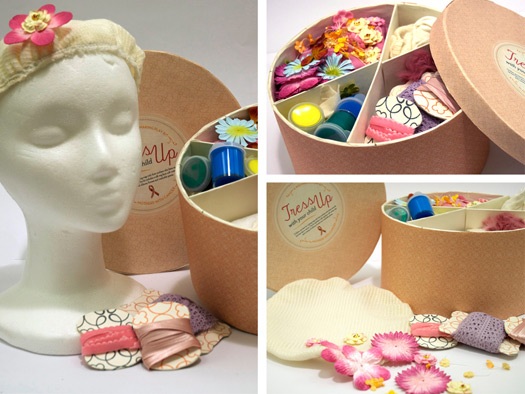
The Tress Up Box: containing head-decorating art supplies to help children through their anxiety around chemotherapy
Submitted by: Allan Chochinov
School: School of Visual Arts
Level: Graduate
Program: MFA Designer as Author: Design in 3 Dimensions
Instructor: Allan Chochinov
Class Project: Women and Girls
Date: Fall 2009
Description: The Women and Girls project was inspired by Half The Sky, Nicolas Kristof and Sheryl WuDunn's chronicle of the plight of girls and women around the world — from gendercide and sex slavery to poverty and lack of access to healthcare and education. Though sobering in detail and narrative, the book is consistently optimistic (promised by its subtitle, "Turning Oppression into Opportunity for Women Worldwide"), offering repeated examples of transformation, entrepreneurship, and hope. For the project kick-off, popular videos such as The Girl Effect and Dove's Campaign for Real Beauty were screened in the class, followed by guest Elizabeth Scharpf, founder of Sustainable Health Enterprises, who presented her work around creating sustainable, affordable, locally-produced sanitary pads, and discussed the notion of design intervention and its challenges.
At the end of the three-hour class, students were asked to commit — on the spot — to a topic for the remainder of the semester (4 weeks). The only constraint was that the subject had to concern itself with girls and/or women and that it had to be personal or local in some way. One student had a family history of breast cancer, and wanted to do a project around the topic. Another student had worked as a nanny, and decided her project would focus on the issues and challenges of caring for someone else's children. A third student's alcoholic father had fatally injured a man in a car accident, and was incarcerated for much of the student's childhood. He undertook a project around how his mother was able to cope with the events of their past. By the end of the class, each of the students had chosen a topic — all unique, and all very personal. Through a rigorous process of primary and secondary research, drawing, prototyping, and branding, the students arrived at solutions spanning straight-up product design through community intervention, technology hacking, and advocacy campaigns. "Mother to Mother," inspired by phone sex advertisements, matched new mothers to grandmothers for spontaneous call-in parenting wisdom. "Tress Up" introduced a box of head-decorating art supplies to help children through their anxiety around a parent's hair loss during chemotherapy. "Nursling" created an ergonomically innovative nursing sling, with instructions, packaging, advertisements, and business plan. "Role Models and Rice" explored the territory between tourism, role models, and local commerce in Cambodia, while "Girl Box" introduced a series of craft kits, also inspired by female role models, and concentrating on knowledge acquisition and skill building. In all, 21 projects emerged, each inspired by the stories told by Kristof and WuDunn, each refracted through the students' personal point of view, and each informed by investigation and making.
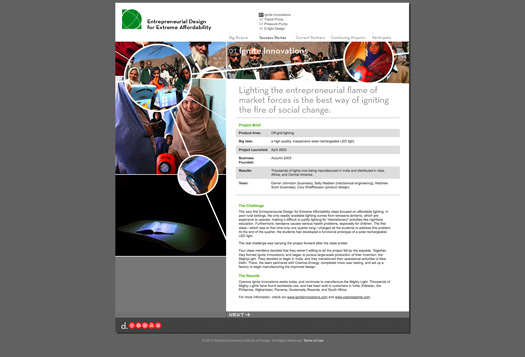
Page from the Entrepreneurial Design for Extreme Affordability website
Submitted by: Kriss Deiglmeier
School: Stanford Graduate School of Business
Level: Graduate Program in Management (MBA)
Program: Executive Director, Center for Social Innovation, Lecturer Social Innovation through Corporate Social Responsibility and Critical Analytical Thinking
Courses: Entrepreneurial Design for Extreme Affordability, Biodesign Innovation, The Power of Social Technology
Instructors: Varied
Description: The Center for Social Innovation (CSI) cultivates leaders to solve the world’s toughest social and environmental problems. We focus on cross-sector solutions and reach outside the silos of the nonprofit, business, and government worlds to educate and connect people, organizations, and ideas. We focus on cross-boundary leadership because we recognize it takes strong leaders to build strong organizations to deliver and achieve social impact. CSI’s offerings include a certificate in public management and social innovation, global service learning trips, subsidized social impact summer internships, social innovation fellows program, executive education programs, conferences, case development, research, pro-bono alumni consulting services and a social innovation podcast channel with over 1.5 million downloads. CSI supports the following social impact design courses in myriad ways.
Courses:
Entrepreneurial Design for Extreme Affordability
Instructors: Jim Patell — GSB, Dave Beach — Engineering
A two-quarter, graduate-level project course where students design comprehensive solutions to challenges faced by the world’s poor. The course is comprised of graduate students from all seven schools at Stanford. The class is project based, and all projects are done in close partnership with a variety of local and international organizations. These organizations host student fieldwork, facilitate the design development, and implement ideas after the class ends. Well known outcomes from the EDEA course: D.ight, more here. Embrace Global, more here.
Biodesign Innovation
Instructors: Stefanos A. Zenios, GSB, Dr. Paul Yock
Medicine and Mechanical Engineering The two-quarter elective course series provides lectures from a diverse group of faculty that expose students to the practical aspects of technology invention and development. Students work in small project teams in the Biodesign prototyping lab or bench space, collaborating with the fellows of the program.
The Power of Social Technology
Instructor: Jennifer Aaker, GSB
The goal of this seminar is to investigate how social technology (e.g., blogs, websites, podcasts, widgets, community groups, social network feeds) can change attitudes and behaviors in ways that cultivate social change. We study the strategies and tactics used by companies and causes that have successfully catalyzed social persuasion.

Submitted by: William Drenttel
School: Yale School of Management
Level: Graduate Program in Management (MBA)
Program: Program in Social Enterprise Class: Management 833 "Designers Designing Design"
Instructors: William Drenttel and Michael Bierut, Senior Faculty Fellows
Class Project: Case Study on Design and Social Enterprise
Date: Winter 2011
Description: Placing design within the larger context of real world projects and enterprises is critical for design thinking and solutions to evolve as a methodology and a means for social impact. In business schools, numerous case studies focus on social enterprise management and others on the role of design in business. But not many have considered the role of design in social enterprises. Yale School of Management, in collaboration with Winterhouse Institute, has created a new series of cases focusing on design and social enterprise, funded by the Rockefeller Foundation. The first case study examines SELCO, a solar energy company in India, and provides an opportunity to examine the strategy of a business with a social purpose and a heavy reliance on innovative design. The options facing SELCO regarding expansion encompass a wide range of possible strategies that will challenge student thinking. The case requires integration of numerous management disciplines (from marketing and finance to human resource management) with insights from design thinking processes and industrial product design approaches. SELCO is the first in a new series of "raw" cases focusing on design and social enterprise; future cases will include the Mayo Clinic Center for Innovation, Project Masiluleke, and Teach For All. The SELCO case study is at: http://nexus.som.yale.edu/design-selco. This new case model is explained here. More information is here. A critical review on Core77. In addition to being taught in this MBA class, it is also being used in other classes at Yale School of Management, as well as at Stanford d-School, School of Visual Arts, and Carnegie Mellon School of Design. Cases are published under a Creative Commons License, so they may be taught free of charge by any school or program interested.
School: Yale School of Management
Level: Graduate Program in Management (MBA)
Program: Program in Social Enterprise Class: Management 833 "Designers Designing Design"
Instructors: William Drenttel and Michael Bierut, Senior Faculty Fellows
Class Project: Case Study on Design and Social Enterprise
Date: Winter 2011
Description: Placing design within the larger context of real world projects and enterprises is critical for design thinking and solutions to evolve as a methodology and a means for social impact. In business schools, numerous case studies focus on social enterprise management and others on the role of design in business. But not many have considered the role of design in social enterprises. Yale School of Management, in collaboration with Winterhouse Institute, has created a new series of cases focusing on design and social enterprise, funded by the Rockefeller Foundation. The first case study examines SELCO, a solar energy company in India, and provides an opportunity to examine the strategy of a business with a social purpose and a heavy reliance on innovative design. The options facing SELCO regarding expansion encompass a wide range of possible strategies that will challenge student thinking. The case requires integration of numerous management disciplines (from marketing and finance to human resource management) with insights from design thinking processes and industrial product design approaches. SELCO is the first in a new series of "raw" cases focusing on design and social enterprise; future cases will include the Mayo Clinic Center for Innovation, Project Masiluleke, and Teach For All. The SELCO case study is at: http://nexus.som.yale.edu/design-selco. This new case model is explained here. More information is here. A critical review on Core77. In addition to being taught in this MBA class, it is also being used in other classes at Yale School of Management, as well as at Stanford d-School, School of Visual Arts, and Carnegie Mellon School of Design. Cases are published under a Creative Commons License, so they may be taught free of charge by any school or program interested.
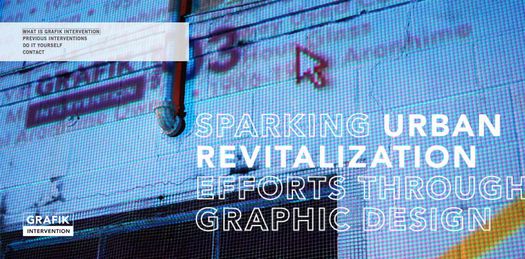
Grafik Intervention home page
Submitted by: Phil Hamlett
School: Academy of Art University
Level: Graduate (MFA)
Program: School of Graphic Design
Class: Thesis Project
Student: William Culpepper
Instructors: Carolina de Bartolo, Marc English, Lian Ng, Anitra Nottingham, Jeremy Stout, Jessica Westbrook
Class Project: Grafik Intervention
Date: Spring 2011
Description: Vacant buildings have become eyesores in many communities throughout our country, a constant reminder of our current economic malaise. In many situations, rehabilitation is too risky, causing developers to pass over these buildings, leaving them subject to urban decay. For William Culpepper, these abandoned buildings and their untapped potential presented a challenge to inspire positive change and help rehabilitate the neglected neighborhoods in which they are found.
As a possible solution, William developed a project dubbed Grafik Intervention, a means to call attention to — and spark urban revitalization amongst — these wounded urban places. Using industrial-sized equipment to project large-format digital images onto the facades of the buildings in question, William presents historical facts, urban context, neighborhood anecdote and community speculation as a captivating nighttime light show.
The projections grab the attention of passersby, who begin to congregate en masse. As interest is piqued and the crowd swells, everone is handed a card with questions pertaining to the property itself and the community in which it resides. Together, the projections and the questionnaire cards get people to notice, take interest, recognize unrealized potential and begin dialogue.
The conversations that ensue encourage residents to look at their surroundings, understand the potential within their communities and do something about it. Through an ongoing process of awareness and engagement, Grafik Intervention encourages positive results by encouraging community members to take pride — and action — in their own neighborhood.
Having undergone numerous iterations, this project's ongoing development is focused upon facilitating deployment in ANY community. An online resource and Intervention Toolkit are available to anyone interested in performing a Grafik Intervention in their own community.
http://grafikintervention.com
http://vimeo.com/grafikintervention
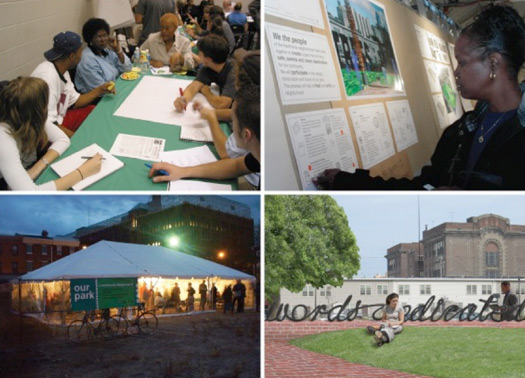
Scenes from "Our Park: A Community Design Open Space Project with the Hawthorne Neighborhood"
Submitted by: Jamer Hunt
School: The University of the Arts, Philadelphia
Level: Undergraduate/Graduate
Program: Industrial Design (ID)
Instructors: Jamer Hunt, Jonas Milder (coordinators)
Class Project: Our Park: A Community Design Open Space Project with the Hawthorne Neighborhood
Date: Spring/Fall 2003 and Spring 2004
Description: The industrial design department was approached by the President of the Hawthorne Empowerment Coalition (HEC) to help their community with the design of an open space on the site of recently demolished Section 8 housing towers. In the Fall of 2003 we organized a three-day, participatory Charrette involving over seventy ID students, eight faculty, and one hundred members of the Hawthorne community, a mixed-income neighborhood near Center City in Philadelphia. Teams focused on outreach to the community and all events were held in the Hawthorne community center, with the exception of the final-day exhibition/party that was held in a tent in the open lot. The students focused on gathering information from community members about their hopes, fears, needs and ideas for an open space in their community. By the end of the three days, students had produced initial concepts for varying aspects of the park, based on themes such as Pathways, History, Security and Play; these were exhibited to the community for feedback at the party.
During an Independent Study in Spring 2004, a smaller, focused group of ID students (again, grad and undergrad) worked together to integrate the initial concepts towards a schematic design for the open space. Each month students and faculty presented the updates at HEC meetings for additional consultation and feedback, creating an iterative process that allowed continuous community input to drive design decisions and refinement. By the end of the spring term, the students had produced detailed concept drawings, supported by supplementary research, to the Hawthorne community. These concept drawings were then handed to Philadelphia Green, a local urban greening organization that had received state funding to turn the concept drawings into construction documents. However, the Philadelphia Housing Authority declared — due to poor financial management by a developer — that they could no longer afford to keep the open space open, and that they would need that space to build more housing that brought revenue back to them. After a two-year political fight by community to preserve the open space, the newly elected Mayor, Michael Nutter, identified $2 million to support the open space project, announcing the first new green space in Center City Philadelphia in decades.
Submitted by: Jamer Hunt
School: Parsons The New School for Design
Level: Graduate
Program: Transdisciplinary Design
Instructors: Miguel Robles-Duran
Class Project: Projects Studio: Emergent Social Forms
Date: Spring 2011
Description: With the proliferation of communication technologies that link people more directly, a growing number of social forms are emerging from open networks. In some cases, these are challenging the hegemony of centralized networks in power and scope. In this course, students investigate ways of triggering small-scale social change. While they may not necessarily utilize communication technologies, students are required to prototype networks, nodes and rule-sets that activate and build community. Whether these schemes are local or global, analog or digital, their emphasis is on harnessing the power of swarms. Students further explore the working methodologies that the design curriculum emphasizes. The level of complexity is increased; working in groups, students address broader, more socially challenging situations. Students are expected to research and analyze social networks and the emergent practices that help to form them, as well as develop strategies for fostering new kinds of communities and networks. Emphasis is placed on the ability to frame a design brief on an achievable scale and to create final proposals that provide criteria for self-assessment.
For Fall 2011, Rupal Sanghvi, founder of HealthxDesign, has invited the graduate program in Transdisciplinary Design to participate as consultants in a large-scale project to re-imagine the “supermarket” in order to bring large-scale/low-cost produce distribution into low-income neighborhoods. In order to optimize the federal investment that will promote supermarket access in low-income neighborhoods, re-thinking the “design-template” of the supermarket could be a potent way to improve healthy food consumption. The current supermarket developer utilizes a well-honed template that effectively modulates behavior, while maximizing profit. Due to a variety of complex factors, this template often promotes the very consumption patterns that are contributors to the obesity epidemic, including consumption of sodas, sugar cereals and other packaged goods with a high level of preservatives. While the average American supermarket is about 50,000 square feet, the area dedicated to healthy choices is relatively small. As part of a long-term planning grant from the USDA focusing on obesity and access to fresh fruits and vegetables, students will work in small collaborative teams with HeathxDesign to research and identify community partners and innovative pilot programs — in addition to food distribution systems, community assets and municipal and state resources — to generate new thinking about how low-income communities best access healthy foods. Students will develop innovative system and service scenarios as well as schematic design proposals driven by community consultation and stakeholder participation to experiment with alternative distribution channels and mechanisms. Additionally, students will focus on health as a larger rubric under which to design a “supermarket,” exploring service, system and building typologies that offer education, activity, community, access to care and food provision within one larger integrated system.
Level: Graduate
Program: Transdisciplinary Design
Instructors: Miguel Robles-Duran
Class Project: Projects Studio: Emergent Social Forms
Date: Spring 2011
Description: With the proliferation of communication technologies that link people more directly, a growing number of social forms are emerging from open networks. In some cases, these are challenging the hegemony of centralized networks in power and scope. In this course, students investigate ways of triggering small-scale social change. While they may not necessarily utilize communication technologies, students are required to prototype networks, nodes and rule-sets that activate and build community. Whether these schemes are local or global, analog or digital, their emphasis is on harnessing the power of swarms. Students further explore the working methodologies that the design curriculum emphasizes. The level of complexity is increased; working in groups, students address broader, more socially challenging situations. Students are expected to research and analyze social networks and the emergent practices that help to form them, as well as develop strategies for fostering new kinds of communities and networks. Emphasis is placed on the ability to frame a design brief on an achievable scale and to create final proposals that provide criteria for self-assessment.
For Fall 2011, Rupal Sanghvi, founder of HealthxDesign, has invited the graduate program in Transdisciplinary Design to participate as consultants in a large-scale project to re-imagine the “supermarket” in order to bring large-scale/low-cost produce distribution into low-income neighborhoods. In order to optimize the federal investment that will promote supermarket access in low-income neighborhoods, re-thinking the “design-template” of the supermarket could be a potent way to improve healthy food consumption. The current supermarket developer utilizes a well-honed template that effectively modulates behavior, while maximizing profit. Due to a variety of complex factors, this template often promotes the very consumption patterns that are contributors to the obesity epidemic, including consumption of sodas, sugar cereals and other packaged goods with a high level of preservatives. While the average American supermarket is about 50,000 square feet, the area dedicated to healthy choices is relatively small. As part of a long-term planning grant from the USDA focusing on obesity and access to fresh fruits and vegetables, students will work in small collaborative teams with HeathxDesign to research and identify community partners and innovative pilot programs — in addition to food distribution systems, community assets and municipal and state resources — to generate new thinking about how low-income communities best access healthy foods. Students will develop innovative system and service scenarios as well as schematic design proposals driven by community consultation and stakeholder participation to experiment with alternative distribution channels and mechanisms. Additionally, students will focus on health as a larger rubric under which to design a “supermarket,” exploring service, system and building typologies that offer education, activity, community, access to care and food provision within one larger integrated system.
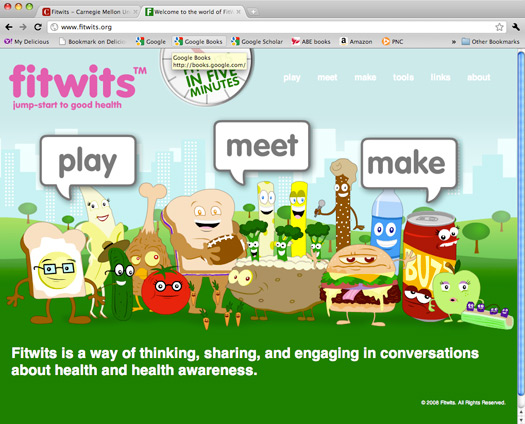 Page from the Fitwits website
Page from the Fitwits website
Submitted by: Terry Irwin
School: Carnegie Mellon University
Level: BFA/MFA
Program: School of Design
Instructors: Kristin Hughes
Research Project: Fitwits: Teaching Kids a Healthy Lifestyle
Date: 2008 to present
Link: www.fitwits.org
Description: Fitwits is a collaborative research project designed by The School of Design at Carnegie Mellon University and UPMC Saint Margaret Family Health Centers, and is funded by The Heinz Endowments. The transdisciplinary project team is comprised of CMU instructors and students, professors from Duquense University, The University of Pittsburgh, a variety of local healthcare professionals and key individuals from local elementary schools. The project was developed to address childhood obesity and nutrition through engagement at 3 key points of contact: schools, health care centers and families themselves. Over the past two years, the team has developed a methodology for effectively integrating schools, doctors’ offices and families in order to develop affordable and easy to use health communications and services. These communication and educational tools are aimed at educating children and their families about healthy living and positive lifestyle choices.
Currently, the Fitwits School Program is used in fifth grade classrooms in five urban schools affiliated with a school health partnership. This partnership pairs family medical resident physicians with schools to provide health promotion and education. The fifth graders are racially diverse and primarily live in low-to-mid socioeconomic urban families. The Fitwits School Program is centered on 34 cartoon characters that epitomize healthy foods and desirable lifestyle choices. The first two phases of the program provided communication aids for use in primary schools and to doctors and health care workers: A series of games and activities, designed by CMU students have been developed to teach children the principles of proper nutrition and can also be used to break down the barriers to effective discussion between doctors and families about childhood obesity and proper lifestyle choices. The final phase has been based in local community centers to engage families in healthy lifestyle activities and engage and educate parents themselves as ‘Fitwit Champions’. These ‘Fitwit Zones’ integrate and expand on the tools and services developed for school interventions and family health clinics to engage parents and families. Because this is an ongoing research project, students have been involved in the context of both classroom projects as well as independent study, providing them with the opportunity for ongoing collaborative engagement with other team members and the local community and especially the children. More about the project can be found on the Fitwits website and here.
Project Collaborators: CMU School of Design, Department of English, Department of Human and Social Sciences, UPMC St. Margaret Bloomfield Garfield Family Health Center, Children’s Hospital of Pittsburgh, UPMC St. Margaret Family Medicine Residency Program, Allegheny County Health Department, Elementary Schools: Fort Pitt ALA, Woolslair, Arsenal, Pittsburgh Montessori and Urban League Charter of Pittsburgh School, The Bloomfied Garfield Corporation.
 Students participating in Island: Imagining a Sustainable Society
Students participating in Island: Imagining a Sustainable Society
Submitted by: Terry Irwin
School: Schumacher College, Plymouth University, UK
Level: MSc
Program: Applied Holistic Science
Instructors: Terry Irwin, Gideon Kossoff, Seaton Baxter
Course Project: Island: Imagining a Sustainable Society
Date: 2006
Description: Island was taught as a transdisciplinary, team-based project over the course of 4 weeks within the Masters program for Holistic Science at Schumacher College, a center for environmental studies in Devon, England. Two transdisciplinary teams were formed from a cohort of 12 masters students with backgrounds in: biology, environmental studies, forestry, social work, economics, business, art, filmmaking and diplomacy. The studio-based design project challenged each team to envision the development of a sustainable society over the course of 450 hypothetical years. The two teams were ‘placed’ on two different uninhabited islands with with a limited number of hypothetical supplies, a partner or friend of choice (to ensure a varied gene pool for future generations) and unlimited access to 21st century knowledge. Two scale models of islands approximately 6’ square (based upon actual island in the Azores) were provided as focal points for discussion, planning and conceptualization and a set of environmental parameters based upon the actual islands was provided (native flora, fauna, climate conditions, rivers, estuaries, soil composition, topology etc.)
The teams were asked to envision the development of a society on the island over the course of 450 hypothetical years and through daily presentations show how they would address issues such as ‘carrying capacity of the island’, development of an agriculture system, preservation of wild areas, development of educational/healthcare infrastructure, modes of economic exchange and art/culture/religious beliefs. Managing/mapping population size and genealogy was also required. A schedule with milestones was provided, with each project day representing a specified number of years in each society’s development. Specified objectives for the project included:
1. Enable students to view the challenges and issues a developing society faces within the context of long horizons of time; to develop the ability to think in terms of decades, lifetimes and generations when conceiving designs and solutions to problems.
2. To develop an understanding of design as an emergent property of humans satisfying their needs (in both sustainable and unsustainable ways) and the effects this has on both society as a whole and the environment.
3. Develop the ability to collaborate successfully in multi-disciplinary teams and to conceive multiple design solutions through visualization and prototyping techniques (as non-designers, students had little experience with these techniques).
4. Apply principles of Holistic Science (emergence, chaos/complexity theories, Gaia theory, self-organization, permaculture principles, cooperation etc.) to proposed design solutions.
A final presentation by each team included design solutions for sustainable dwellings, farming, management of livestock, formulation of systems of education and governance, development of language, forms of art and handcrafts and apparel. Each society developed a method of ‘phenomenological journaling’ and storytelling as a way of communicating the qualitative nature of their society as well as its ‘culture’ including worldview, beliefs and ‘taboos’. Learning objectives for this project were centered on process, not final design solutions and the ability of students to gain an appreciation of the complexity and interdependent nature of ‘wicked’ problems and the need to think in longer horizons of time with respect to design solutions and lifestyle choices. The project essentially asked, “if you could start from scratch, what would you do differently?”. A project manual was created for the assignment which also recorded the results of each teams’ efforts.
From the Community Heathcare Worker Toolkit (for UN Millenium Villages)
Submitted by: Debera Johnson
Level: Recent Graduates from the Institute
Program: Instructors: Debera Johnson
Project: Pratt Design Incubator for Sustainable Innovation
Date: Started 2002
Description: The Pratt Design Incubator for Sustainable Innovation is a vibrant and energetic entity whose primary goal is to link ambition to sustainability to enterprise. It is a highly collaborative space that taps an extensive network of creative people to work on for profit and not for profit projects that combine environmental and social responsibility with successful outcomes. In addition the Incubator helps recent Pratt alumni start-up socially responsible businesses. Start-ups become part of an entrepreneurial community that supports their development from business plan to angel funding. The Incubator engages mentors from all areas of business, engineering and design. Based at Pratt Institute, a premier college of art, design and architecture and located in NYC, the Incubator has the capacity to manage and deliver innovative socially responsible businesses and implement products and services by assembling the right project with the right team.
The Incubator offers the following services:
— Free start-up support and space for social entrepreneurs
— Strategic design consulting services to for profit and non profit organizations
— Workshops and seminars in sustainability and entrepreneurship
— Free access to the CSDS Resource Center
— Free access to the Incubator's Mentors
Pratt Design Incubator for Sustainable Innovation was founded in 2002 and has supported the launch over 14 businesses and consulted on sustainable design projects for the UN, The Earth Institute, UNESCO, Sustainable South Bronx and many others non- profit and for profit organizations. More information about the incubator here.
Submitted by: Debera Johnson
School: Pratt Institute, Design Incubator for Sustainable Innovation
Level: Undergraduate and Graduate Interns, Alumni and others
Program: UN Millennium Village Project — Healthcare/Earth Institute
Project Director: Debera Johnson
Project: Community Heathcare Worker Toolkit (for UN Millennium Villages)
Date: Spring 2009
Client: Earth Institute
Project: Train and support a new strata of local Community Healthcare Workers in 72 villages in Africa and Asia. The Incubator brought together a group of over 40 designers and artists to translate 2000 pages of clinical information into a 200 page toolkit that helps CHWs recognize serious heath issues and educate the community about hygiene and nutrition. The CHWs are from the community they serve, have the equivalent of a high school education and are being trained and equipped to perform 70% of necessary services through household visits — shown to be the most effective means for reducing infant mortality and supporting women's health. The project has been introduced in Uganda and Tanzania. It was designed to be customized to the local traditions and mythologies and is now in it's fourth iteration. The design set the stage for significantly increasing the number of healthcare providers, ultimately projected to bring life saving services to over 500,000 people in the next two years.

Condoms and Beer: From the Man Shield Campaign
Submitted by: Jon Kolko
School: Savannah College of Art and Design
Level: BFA, Industrial + Interaction Design, Senior Project
Program: IACT435 Senior Interaction Design Studio
Instructors: Jon Kolko
Class Project: Final Interaction Design Project, Self-Defined & Self-Paced
Date: Spring 2007
Designer: Lynde Kintner
Description: The Man Shield is a simple and powerful campaign to couple condoms with beer, distributed at bars, and tied to information about STDs and humor. The acquisition of condoms is a challenge to most individuals. The organization and planning required are only half of the problem. The other half deals with the cultural pressures that one encounters when purchasing condoms, which make the experience altogether unpleasant. The expiration and temperamental packaging coupled with the sporadic occurrence of casual sex produce a major obstacle between the user and a condom. By piggybacking a condom on another product — a product the user was already going to purchase — makes this transaction fully parallel to the user's lifestyle.
Most individuals will not seek out information on STDs, especially if they are engaging in risky behavior, because it is a frightening topic to confront. Furthermore, most individuals do not have an appropriate catalyst to utilize to spark discussion in a social setting. By allowing humor to navigate the delivery of culturally relevant reasoning, the catalyst is not only created, but the topic now becomes less scary and cumbersome. Alcohol can be used as a vehicle for delivery. Most interview participants noted alcohol's negative effect on their judgment. Findings also pointed out the power of alcohol to lead to interpersonal bravery and detailed discussions that might never have occurred if alcohol had not been an influence. Therefore, by presenting the topic of sexuality and sexual behavior in tandem with the alcohol that individuals are consuming, this has a direct impact on conversation and its subject matter.
Most participants understood the benefits of a condom; however, very little used the product in accordance with the knowledge they held regarding its necessity and the prevalence of STDs. We have learned these ideas in a static classroom setting, which naturally separates the student from the subject being taught. Furthermore, we understand more about the context and long term affects of STDs than the context and manner in which they are distinctly transmitted from one person to another. Finally, the jovial atmosphere of any bar or club makes it easy to forget that real risks exist. Because the product exists in such close proximity to the domain of casual sexual acts, it resounds long enough in the user's mind to have an effect on behavior. Ultimately, the combination of frank, factual information, with humorous cultural reasoning targets both the logical and illogical aspects of an individual that govern the choices that they make regarding personal sexual behavior. You can read more about this project at at here.

Reporting on Design and Social Change
Submitted by: Julie Lasky
School: School of Visual Arts
Level: MFA
Program: Design Criticism (D-Crit)
Class: Reporting on Design and Social Change
Instructor: Julie Lasky
Class Projects: Interviewing and profile writing
Date: Fall semester (8-week class)
Description: The North Carolina journalism professor Anthony Curtis describes investigative reporters as “those who uncover facts and write articles that expose waste, wrongdoing, mismanagement, fraud, conflict of interest and abuse of authority, and promote change and reform.” Such pursuits have been absent in much design journalism and particularly in a realm that occupies this class: social innovation. Ironically, given their emphasis on promoting change and reform, media stories about design in the service of the environment, health, education, and economic development often lack journalistic rigor, especially in the blogosphere. In this eight-week course, we work on skills for researching and producing hard-hitting features, with an emphasis on profile writing.
This class is not about investigative reporting per se, but offers tools and inspiration for probing the journalistic subject. Classic writings by Jane Jacobs, Rachel Carson, and Jessica Mitford, are assigned. Authors of exemplary books (Elizabeth Royte, Alissa Quart) and groundbreaking journalism (Danielle Rich on William McDonough, Jeff Chu on Design within Reach) have visited the class to discuss their strategies and experiences in getting the story. Other sessions are devoted to journalistic techniques and ethics.
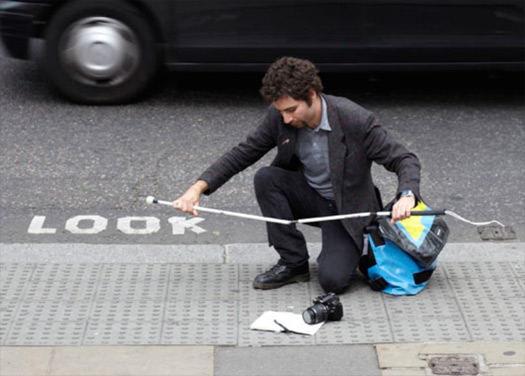
Research associate Ross Atkins examines tactile paving in London, 2010, as part of project for Commission for Architecture and Built Environment
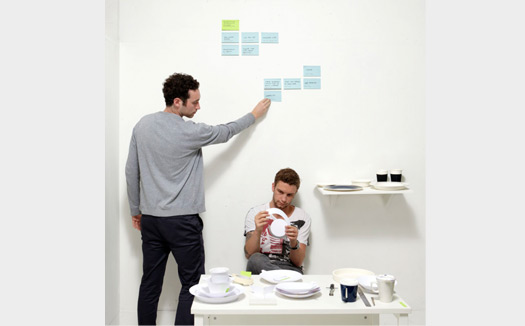
Research associates Gregor Timlin (left) and Nic Rysenbry assess key features of tableware designs in project on design for dementia with Bupa care homes
Submitted by: Jeremy Myerson
School: Helen Hamlyn Centre, Royal College of Art
Level: Post-MA
Program: Helen Hamlyn Research Associates Program
Instructors: Jeremy Myerson and Rama Gheerawo
Class Project: Various
Date: Annual. Start: 1 October. Finish: 30 September
Description: Over a ten-year period, the Helen Hamlyn Centre at the Royal College of Art has teamed up more than 100 RCA design graduates with research partners in industry government and the non-profit sector to address the key social challenges in ageing, health and work through design research. The Helen Hamlyn Research Associates Program, as the scheme is called, employs the graduates for one calendar year on a supervised education program and facilitates real-world projects with external partners. These have included Unilever, GlaxoSmithKline, Orange, Ford, Toyota, IDEO, Nokia, Philips, Hewlett-Packard, the Design Council and the British Heart Foundation. Within the College, the Departments of Architecture, Communication Art and Design, Design Interactions, Design Products, Industrial Design Engineering and Vehicle Design have become regular collaborators. An early emphasis on design for age and disability on the program soon broadened to embrace research projects dedicated to improving patient safety and working life and developing innovative ideas for business as digital technology opened up new opportunities. As an applied research program, it deliberately sits midway between academia and business. Masters graduates unconstrained by PhD demands are paid as part-time RCA staff researchers undertaking projects directly with industry. Companies and charities pay to collaborate with a graduate under the aegis of the centre, which manages both selected design graduates and external partners.
Each project is divided into four distinct phases in line with the three terms of the RCA academic year and the summer break: the Discover phase (autumn term), Define (spring term), Develop (summer term) and Deliver (summer break). The Discover phase (October-December) follows an induction period with professional skills training in such areas as project management, presentation, user research, writing and filmmaking. This is a period for exploration. Researchers investigate the context of the project and learn to conduct market analysis, reviewing the literature, and building a working relationship with the research partner. Define (January-March) is a time to focus — preliminary user studies help to define a point of view and decide which areas or ideas to prioritize. Early design concepts are generated through prototyping. The third phase of the program, Develop (April-June), consolidates design directions in partnership with the research partner. Scenarios and prototypes are created. Relevant processes and technologies are investigated. Ideas are validated with experts and in user trials. Modifications are made and final communication outputs are determined as the project enters the final straight. The Deliver phase (July-September) completes the project by giving the partner the results and outcomes of the study in a form that is of the most practical and applicable use to the organization – whether exemplar designs, prototypes, films, guidelines or publications. The final results of the Research Associates projects are publicly disseminated via an annual show and symposium at the RCA each September, held as part of the London Design Festival.
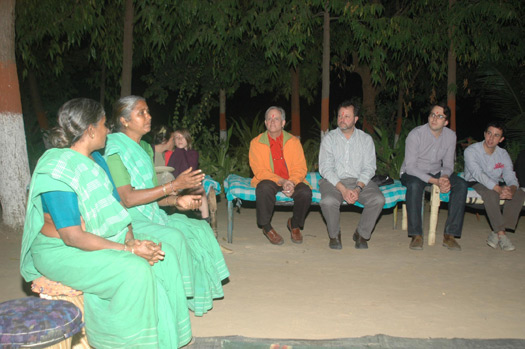 Yale Global Social Entrepreneurship class. SEWA organic farm, Ahmedabad, India 2010
Yale Global Social Entrepreneurship class. SEWA organic farm, Ahmedabad, India 2010
Submitted by: Tony Sheldon
School: Yale School of Management
Level: Graduate Program in Management (MBA)
Program: Program in Social Enterprise
Classes: Global Social Entrepreneurship; Managing Social Enterprises in Developing Countries; Microfinance and Economic Development
Instructor: Tony Sheldon, Executive Director, Program on Social Enterprise; Lecturer in Economic Development
Class Projects: Consulting projects with social enterprises.
Date: Fall and spring semesters
Description:The Yale Program on Social Enterprise (PSE) supports scholars, students, alumni, and practitioners interested in exploring the ways in which business skills and disciplines can be harnessed to most effectively and efficiently achieve social objectives. PSE facilitates work on nonprofit and public sector social entrepreneurship as well as initiatives in private sector social enterprise. PSE’s activities span courses, research, conferences, and publications. In addition to these formal activities, PSE serves as a focal point for social enterprise-related activities at SOM, facilitating, advising, and drawing connections among students, faculty, the Yale community, and the broader network in the US and internationally of interested practitioners and institutions. PSE’s most recent publication is “Making the Connection: Partnerships in Development Finance and Sustainable Energy,” which grew out a year-long research project and a conference hosted by Yale in April 2010. The report is available here. PSE, in collaboration with Winterhouse Institute, also recently published an online case study on SELCO, a solar energy company working with over 100,000 households in southern and western India, see here.
The “Global Social Entrepreneurship” course is designed to introduce students to practical issues faced by mission-driven social entrepreneurs, linking teams of Yale students with social enterprises (SEs) in India. Student/SE teams work together to address specific management challenges faced by the SEs, culminating with the development of a set of recommendations (operational, financial or otherwise) to meet the identified challenges. All students in the class travel to India to work with their partners, either during the summer before or during the winter just after the fall class.
“Managing Social Enterprises in Developing Countries” selects a different country each year for pro bono consulting projects with social enterprises and non-profit organizations. GSE has worked with organizations in South Africa, Madagascar, Colombia, Thailand, Brazil, and (in 2011) Peru. Student teams manage their projects remotely throughout the spring semester, traveling to the country to work directly with their clients for one week during the spring recess.
“Microfinance and Economic Development” explores the successes and limitations of microfinance as an economic development strategy, with a focus on the role of microfinance in international poverty alleviation efforts. The course examines the evolution of the field, from both theoretical and practical perspectives, including current debates about the pros and cons of the increasing trend toward commercialization of the field.
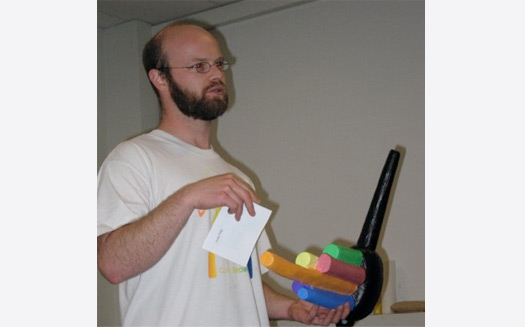 Erik Peterson introduces the proof-of-concept for Qeej Hero in AD502 Transcultural Aesthetics and Contemporary Design
Erik Peterson introduces the proof-of-concept for Qeej Hero in AD502 Transcultural Aesthetics and Contemporary Design
Submitted by: Elizabeth Tunstall
School: University of Illinois at Chicago
Level: MFA
Program: Transdisciplinary: Art and Design
Class: AD502 Contemporary Theory
Seminar: Transcultural Aesthetics and Contemporary Design
Instructors: Dori Tunstall
Class Project: Tranculturally-Based Art and Design
Date: Spring 2009
Description: In contemporary global design praxis, what do the concepts of globalization, beauty, culture, authenticity, art, design, or craft mean? At the intersections of global cultures, what informs the designer’s aesthetic approaches to thinking and making? How is one’s cultural identity implicated in the objects, communications, and experiences one designs? Interrogating notions of purity, authenticity, and tradition, the course was framed by Cuban theorist Fernando Ortiz’s concept of transculturation, which is defined as ‘the reciprocal but uneven selective borrowings from one culture to another.’ It explored the making of transculturally-based aesthetic decisions in contemporary design praxis and the social-political implications of those decisions in U.S. Native America, Mexico, Southern Africa (Zimbabwe) and Aboriginal Australia. Through guest lectures by contemporary designers, such as Saki Mafundikwa and Luis Arnal, and readings across anthropology, art history, design, and philosophy, class co-participants selected a country of their choice for deeper investigation. The first half of the course focused on the creation of a transculturation journal of aesthetic possibilities and their social and political implications based on the co-participant’s selected country/region/culture. This was accomplished through one-page weekly responses to the readings as applied to additional research the participant conducted in his or her cultural area. The second half of the course focused on the creative conceptualization and proof-of-concept of cultural community based projects. Exceptional outcomes of the course include:
— Erik Peterson’s project, “Qeej Hero,” which continues in the development a Guitar Hero-like video game culturally based on the traditional qeej instrument of the Hmong community in the U.S. and was presented at AIGA Make|Think in 2009.
— Xie Zhen’s project, “Chinese Design Identity: A Glimpse into Culture-based Design,” about which she published in the article, "How to Interpret Chinese Design" by Xie Zhen and Zhu Shuai in Observation: Volume 168, August 2009.
This course will be taught as part of Swinburne University’s new Masters of Design (Design Anthropology) program, which
